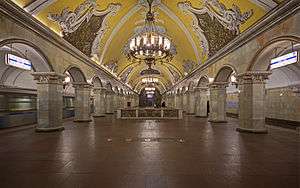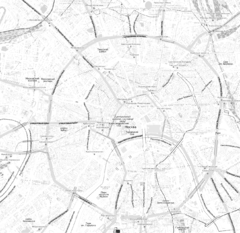Komsomolskaya (Koltsevaya Line)
Komsomolskaya Комсомольская | |||||||||||||||||||||||||||||||||||||||||||||||||||||||||||||||||||||||||||||||||||||||||||||||||||||||||||
|---|---|---|---|---|---|---|---|---|---|---|---|---|---|---|---|---|---|---|---|---|---|---|---|---|---|---|---|---|---|---|---|---|---|---|---|---|---|---|---|---|---|---|---|---|---|---|---|---|---|---|---|---|---|---|---|---|---|---|---|---|---|---|---|---|---|---|---|---|---|---|---|---|---|---|---|---|---|---|---|---|---|---|---|---|---|---|---|---|---|---|---|---|---|---|---|---|---|---|---|---|---|---|---|---|---|---|---|
| Moscow Metro station | |||||||||||||||||||||||||||||||||||||||||||||||||||||||||||||||||||||||||||||||||||||||||||||||||||||||||||
 station hall | |||||||||||||||||||||||||||||||||||||||||||||||||||||||||||||||||||||||||||||||||||||||||||||||||||||||||||
| Location |
Komsomolskaya Square Krasnoselsky District Central Administrative Okrug Moscow | ||||||||||||||||||||||||||||||||||||||||||||||||||||||||||||||||||||||||||||||||||||||||||||||||||||||||||
| Coordinates | 55°46′29″N 37°39′18″E / 55.7748°N 37.6549°ECoordinates: 55°46′29″N 37°39′18″E / 55.7748°N 37.6549°E | ||||||||||||||||||||||||||||||||||||||||||||||||||||||||||||||||||||||||||||||||||||||||||||||||||||||||||
| Owned by | Moskovsky Metropoliten | ||||||||||||||||||||||||||||||||||||||||||||||||||||||||||||||||||||||||||||||||||||||||||||||||||||||||||
| Line(s) | 5 Koltsevaya Line | ||||||||||||||||||||||||||||||||||||||||||||||||||||||||||||||||||||||||||||||||||||||||||||||||||||||||||
| Platforms | 1 island platform | ||||||||||||||||||||||||||||||||||||||||||||||||||||||||||||||||||||||||||||||||||||||||||||||||||||||||||
| Tracks | 2 | ||||||||||||||||||||||||||||||||||||||||||||||||||||||||||||||||||||||||||||||||||||||||||||||||||||||||||
| Connections |
Leningradsky Rail Terminal Yaroslavsky Rail Terminal Kazansky Rail Terminal Bus: 40, 122 Trolleybus: 14, 41 Tram: 7, 37, 50 | ||||||||||||||||||||||||||||||||||||||||||||||||||||||||||||||||||||||||||||||||||||||||||||||||||||||||||
| Construction | |||||||||||||||||||||||||||||||||||||||||||||||||||||||||||||||||||||||||||||||||||||||||||||||||||||||||||
| Structure type | Deep column tri-vault | ||||||||||||||||||||||||||||||||||||||||||||||||||||||||||||||||||||||||||||||||||||||||||||||||||||||||||
| Depth | 37 metres (121 ft) | ||||||||||||||||||||||||||||||||||||||||||||||||||||||||||||||||||||||||||||||||||||||||||||||||||||||||||
| Platform levels | 1 | ||||||||||||||||||||||||||||||||||||||||||||||||||||||||||||||||||||||||||||||||||||||||||||||||||||||||||
| Parking | No | ||||||||||||||||||||||||||||||||||||||||||||||||||||||||||||||||||||||||||||||||||||||||||||||||||||||||||
| Other information | |||||||||||||||||||||||||||||||||||||||||||||||||||||||||||||||||||||||||||||||||||||||||||||||||||||||||||
| Station code | 070 | ||||||||||||||||||||||||||||||||||||||||||||||||||||||||||||||||||||||||||||||||||||||||||||||||||||||||||
| History | |||||||||||||||||||||||||||||||||||||||||||||||||||||||||||||||||||||||||||||||||||||||||||||||||||||||||||
| Opened | 30 January 1952 | ||||||||||||||||||||||||||||||||||||||||||||||||||||||||||||||||||||||||||||||||||||||||||||||||||||||||||
| Traffic | |||||||||||||||||||||||||||||||||||||||||||||||||||||||||||||||||||||||||||||||||||||||||||||||||||||||||||
| Passengers (2009) | 54,469,315 | ||||||||||||||||||||||||||||||||||||||||||||||||||||||||||||||||||||||||||||||||||||||||||||||||||||||||||
| Services | |||||||||||||||||||||||||||||||||||||||||||||||||||||||||||||||||||||||||||||||||||||||||||||||||||||||||||
| |||||||||||||||||||||||||||||||||||||||||||||||||||||||||||||||||||||||||||||||||||||||||||||||||||||||||||
| |||||||||||||||||||||||||||||||||||||||||||||||||||||||||||||||||||||||||||||||||||||||||||||||||||||||||||
| Location | |||||||||||||||||||||||||||||||||||||||||||||||||||||||||||||||||||||||||||||||||||||||||||||||||||||||||||
  Komsomolskaya Location within Central Moscow | |||||||||||||||||||||||||||||||||||||||||||||||||||||||||||||||||||||||||||||||||||||||||||||||||||||||||||
Komsomolskaya (Russian: Комсомо́льская) is a Moscow Metro station in the Krasnoselsky District, Central Administrative Okrug, Moscow. It is on the Koltsevaya Line, between Prospekt Mira and Kurskaya stations.
The station is noted for its being located under the busiest Moscow transport hub, Komsomolskaya Square, which serves Leningradsky, Yaroslavsky and Kazansky railway terminals. Because of that the station is one of the busiest in the whole system and is the most loaded one on the line. It opened on 30 January 1952 as a part of the second stage of the line.
Evolution of the design
While the first southern segment of the Koltsevaya Line were dedicated to the victory over Nazi Germany, the northern segment (Belorusskaya-Koltsevaya to Komsomolskaya) was dedicated to the theme of post-war labour. Komsomolskaya, however, is a clear exception: lead designer Alexey Shchusev designed it as an illustration of a historical speech given by Joseph Stalin November 7, 1941. In this speech, Stalin evoked the memories of Alexander Nevsky, Dmitry Donskoy and other military leaders of the past, and all these historical figures eventually appeared on the mosaics of Komsomolskaya.
Early roots of the station's design can be traced to a 1944 draft by Shchusev implemented in pure Petrine baroque, a local adaptation of the 17th century Dutch Golden Age. However, after the end of World War II the drafts of 1944 were discarded and the stations of the Koltsevaya Line were completed in the mainstream late stalinist style of the period. Shchusev however, who died in 1949, retained his baroque nonce order.
Komsomolskaya remained Shchusev's first and only metro station design. The station was initially planned as a traditional deep pylon type. Later, Shchusev replaced the heavy concrete pylons with narrow octagonal steel columns, riveted with marble tiles, creating the larger open space.
After Shchusev's death, the station was completed by Viktor Kokorin, A. Zabolotnaya, V. Varvarin and O. Velikoretsky and Pavel Korin, the creator of the mosaics.
Architecture and decoration
Beginning with the large vestibule located among the former of the two train stations, the building features an immense octagonal dome topped by a cupola, and a spire crowned by a large star and imposing full-height portico with stylised Corinthian columns. Inside amid the Baroque-style ornaments, rich torchères and chandelier lights, two escalators descend, one leading to the old 1935 Komsomolskaya-Radialnaya station, and the second to this one.
Once on the platform level, the full details of this deep column station built to special design on a monolithic plan become apparent; there is an imposing Baroque ceiling, with accompanying friezes, painted yellow. Supporting the enlarged barrel vault are 68 octagonal columns faced with white marble, and topped with baroque pilasters. The platform is lit up by chandeliers and additional concealed elements in the niches of both the central and platform halls.
The theme of the design, the Historical Russian fight for freedom and independence, is expressed in eight large ceiling mosaics by Pavel Korin. Korin said that the inspiration came from Joseph Stalin's speech at the Moscow Parade of 1941, where he inspired the soldiers amid the catastrophic losses in the early period of World War II to remember the historical heroics of their Russian forefathers. The idea to design the art as a mosaic came from the Saint Sophia Cathedral in Kiev, where Korin saw that such artforms could last for eternity. Chronologically the mosaics are as following:
- 1242: Alexander Nevsky after the Battle on the Ice.
- 1380: Dmitry Donskoy after the Battle of Kulikovo.
- 1612: Kuzma Minin and Dmitry Pozharsky after the end of the Time of Troubles.
- 1799: Alexander Suvorov after the Crossing of the Alps.
- 1812: Mikhail Kutuzov after the Battle of Borodino.
- 1945: The original mosaic here was of Red Army troops on Red Square receiving the Guards banner from Soviet army command, yet because it contained images of some commanders whose careers and legacy would later be re-evaluated (including Joseph Stalin) most of the mosaic was replaced with that of Vladimir Lenin addressing a meeting in Red Square, thus moving the date of the artwork to a period between 1917 and 1922.
- 1945: Soviet Troops on the Reichstag building after the Battle of Berlin (according to some, the original banner had superimposed profiles of Lenin and Stalin: the latter was removed to leave just Lenin remaining).
- 1945: The original image was of a Victory parade with Soviet soldiers throwing captured Nazi banners in front of Lenin's mausoleum. However, for the same reason as the sixth image, this image would hold the record for retouchings. First when Lavrenty Beria was arrested in 1953, his glasses were erased and then the whole figure was removed. Then in 1957, after the political crisis saw the end of the careers of Vyacheslav Molotov and Lazar Kaganovich, their images followed suit. Finally, after 1961 brought the end of Stalin's personality cult, in early 1963 the whole panel was taken down and Korin re-designed it by placing a maiden (symbolising Mother Russia) standing on the Nazi banners in front of the same mausoleum, holding a hammer and sickle in one hand and a palm branch in the other. This final one alone is made of more than 300 thousand mosaic tiles and takes up 31.5 square metres and weighs more than three tonnes.
However the artistic decoration does not stop there, for in between each of the mosaics there are further ones made of gilded smalt depicting various weaponry and armour: one set is focused on ancient Russian equipment, a second on the Napoleonic era, the third on World War II. At the end of the platform is a bust of Vladimir Lenin under an arch decorated with gilt floral designs and the Coat of arms of the Soviet Union.
In the centre of the red granite covered platform are two passageways, surrounded by marble balustrades with escalators that descend into a lobby with a main escalator tunnel upwards to the Sokolnicheskaya Line's Komsomolskaya station. On the wall opposite the escalator is a large fluorescent mosaic, also of Pavel Korin, depicting the Order of Victory surrounded by red and green banners and Georgian colours.
In 1951 both Pavel Korin and Alexey Schusev (posthumously) were awarded the Stalin Prize for their works on the station, and on 30 January 1952 the station was opened to the public as the first on the second stage of the Koltsevaya line. In 1958 the station was awarded the Grand Prix ("Grand Prize") title of Expo '58 in Brussels.
Mosaique Gallery
Station Gallery
_(5226456260).jpg) Artwork on platform
Artwork on platform_(5226451132).jpg) Central hall
Central hall
Notes
| Wikimedia Commons has media related to Komsomolskaya. |